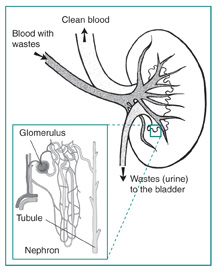Gary Coleman Hospitalized

There are reports today that Diff’rent Strokes star Gary Coleman,41, had been hospitalized. His publicist now confirms that Coleman suffered a “slight seizure” this morning while at his Los Angeles hotel. His rep says, “He’s resting now at the hospital and doctors are monitoring his condition.” Coleman suffered from a kidney problem since infancy, called focal segmental glomerulosclerosis, which accounted for his short stature. He has undergone two kidney transplants, in 1973 and 1984, but still requires dialysis.
What do the kidneys do?
The kidneys are a pair of vital organs that perform many functions to keep the blood clean and chemically balanced. They are bean-shaped, fist-sized organs located near the middle of the back, on either side of the spine just below the rib cage. The kidneys are sophisticated reprocessing machines. Every day, a person’s kidneys process about 200 quarts of blood to filter out about 2 quarts of waste products and extra water. The wastes and extra water become urine, which flows to the bladder through tubes called ureters. The bladder stores urine until releasing it through urination.



The actual removal of wastes occurs in tiny units inside the kidneys called nephrons. Each kidney has about a million nephrons.
In the nephron, a glomerulus—which is a tiny blood vessel, or capillary—intertwines with a tiny urine-collecting tube called a tubule. The glomerulus acts as a filtering unit- it keeps normal proteins and cells in the bloodstream, but allows extra fluid and wastes to pass through. A complicated chemical exchange takes place, as waste materials and water leave the blood and enter the urinary system. At first, the tubules receive a combination of waste materials and chemicals the body can still use. The kidneys measure out chemicals like sodium, phosphorus, and potassium and release them back to the blood to return to the body. In this way, the kidneys regulate the body’s level of these substances. The right balance is necessary for life.
What is focal segmental glomerulosclerosis?
Focal Segmental Glomerulosclerosis (FSGS) is a disease that attacks the kidney’s filtering system (glomeruli) causing serious scarring. FSGS is one of the many causes of a disease known as Nephrotic Syndrome, which occurs when valuable protein in the blood leaks into the urine (proteinuria). Symptoms include:
- Pronounced swelling in parts of the body (edema) most visible in the head, hands and feet.
- Low level protein in the blood (hypoalbuminemia).
- Large amounts of protein in the urine.
Fifty percent of FSGS sufferers, who do not respond to treatment, will go on to end-stage renal disease (ESRD)- meaning kidney failure, within 5 years. At that point they will either need a kidney transplant, or dialysis or the rest of their lives.
We have talked about kidney transplantation in articles about Natalie Cole.
For more information:
| Resounding Health(tm) Nephritis |
























1 Comment